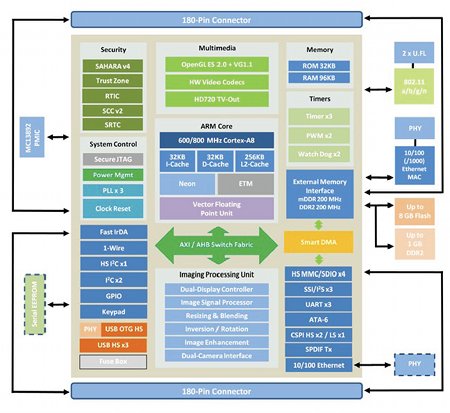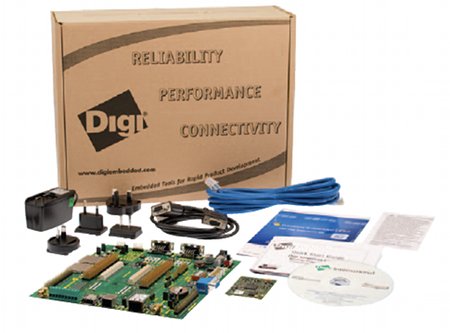Wireless Cortex-A8 module supports Linux
Nov 5, 2009 — by LinuxDevices Staff — from the LinuxDevices Archive — 6 viewsDigi International announced a Linux-compatible ARM Cortex-A8-based module that supports 802.11n WiFi. Built around a Freescale i.MX51 SoC (system on chip), the ConnectCore Wi-i.MX51 includes up to 1GB of RAM and 8GB of flash storage, wireless networking, touchscreen support, and a variety of other interfaces, the company says.
Measuring approximately 3.2 x 2 inches, the ConnectCore Wi-i.MX51 is the latest in a line of ConnectCore modules, which have included:
- the ConnectCore 9M 2443, which was released earlier this year with an Samsung S3C2443 SoC on board
- the ConnectCore 9P 9215, released in 2008 with Digi's NS9215 processor
- the ConnectCore XP, with a Marvell PXA270 processor
- the ConnectCore Wi-9C, employing Digi's NS9360 processor
 The new ConnectCore Wi-i.MX51 (right) clearly offers more processing power than any of the above, thanks to its adoption of Freescale's i.MX51 SoC. The i.MX51 is based on ARM's Cortex-A8 superscalar core which, among other enhancements, enables instruction-level parallelism within a single processor.
The new ConnectCore Wi-i.MX51 (right) clearly offers more processing power than any of the above, thanks to its adoption of Freescale's i.MX51 SoC. The i.MX51 is based on ARM's Cortex-A8 superscalar core which, among other enhancements, enables instruction-level parallelism within a single processor.
According to Freescale, its SoC offers power management features including multiple independent power domains, power gating, and dynamic process and temperature compensation. The company's DVFS (dynamic voltage and frequency scaling) is said to allow throttling down to as low as 200MHz.
Digi says the i.MX51 used on the ConnectCore Wi-i.MX51 runs at 600 or 800MHz, but doesn't otherwise indicate which specific Freescale SoC is being employed. The i.MX51 family made its debut in January of this year with the netbook-focused i.MX515, which clocks at up to 1GHz and integrates OpenGL ES 2.0 graphics acceleration. Yesterday, Freescale announced four more i.MX51 devices, as follows:
- the i.MX512 and i.MX513, which are available in 600 or 800MHz versions but do not include the OpenGL ES 2.0 graphics
- the i.MX514 and i.MX516, which run at 600MHz and support automotive temperature ranges, complete with Open GL ES 2.0
A block diagram (below) for the ConnectCore Wi-i.MX51 does depict OpenGL ES 2.0, leading us to believe that the i.MX515 is the SoC of choice here. Be that as it may, all members of the i.MX51 family are pin-compatible, according to Freescale, making it easy for Digi to adapt its product to customer requirements.

A block diagram of Digi's ConnectCore Wi-i.MX51
(Click to enlarge)
In addition to the SoC, the ConnectCore Wi-i.MX51 includes up to 1GB of DDR2 memory, up to 8GB of flash storage, plus two 180-pin connectors that relay its interfaces to the outside world. According to Digi, the module has three UARTs with IrDA support, up to three USB 2.0 host ports and one USB 2.0 OTG port, 10/100 Ethernet, SD/SDIO/MMC, and 802/11a/b/g/n wireless networking.
Dual displays are supported, with both SD and HD TV output, and there is a four-wire touchscreen interface, according to Digi. Meanwhile, the module is also said to have two camera ports, capable of supporting up to eight megapixels. An onboard image processing unit is capable of video/graphics combining, resizing, rotation/inversion, and color conversion/correction, the company adds.
Digi also offers the ConnectCore Wi-i.MX51 JumpStart Kit (below), a baseboard for the module that is supplied with a BSP (board support package) for either Linux or Windows Embedded CE 6.0 R3.

The Digi ConnectCore Wi-i.MX51 JumpStart kit
While Digi doesn't specify how large the baseboard is, real-world connectors include three serial ports, VGA and HDMI outputs, five USB ports, Ethernet, and audio I/O. The board also has a microSD slot, a SD/MMC slot, sockets for 802.15.4 (ZigBee) and 802.3af (PoE) modules, and LCD/touchscreen connectors.
Optional touchscreens are said to be available in 5.7-, 6.4-, or 7-inch sizes. The baseboard additionally has user pushbuttons and LEDs, the company adds.
Features and specifications listed by Digi for its ConnectCore Wi-i.MX51 module/JumpStart combo include the following:
- Processor — Freescale i.MX51 clocked at 600 or 800MHz
- Memory — Up to 1GB of DDR2 RAM and 8GB of flash storage (JumpStart kit includes 512MB of RAM and 512MB of flash as standard)
- Display:
- Supports primary and secondary displays
- Resolutions up to 1024 x 768 pixels @ 100fps, 1280 x 720 @ 60fps, or 1920 x 1080 @ 30fps
- GPU — 27 million triangles/sec, 166 million pixels/sec raw; OpenVG 1.0, Open GL ES Common Profile v1.0/v1.1/Direct3D Mobile, Open GL ES Profile v2.0
- 4-wire touchscreen interface (connector on baseboard)
- Camera — 2 camera ports supporting up to 8 megapixels @ 15fps
- Expansion:
- SD/MMC (baseboard has microSD and SD slots)
- ZigBee and PoE module slots
- external camera connectors (on baseboard)
- Networking:
- LAN — 10/100 Ethernet (RJ45 connector on baseboard
- WLAN — 802.11a/b/g/n (built into module, with antenna connector on baseboard)
- Other I/O:
- 3 serial ports (1 x RS232, 1 x RS232/422/485, 1 x TTL)
- 1 x VGA port
- 1 x HDMI
- microphone input and line in/out
- 1 x USB OTG
- 4 x USB 2.0 host
- I2C/SPI headers
- Power supply (baseboard) — 9VDC to 30VDC
- Operating temperature (processor speed grade dependent) — -40 to 185 deg. F (-40 to 85 deg. C)
- Dimensions (module) — 3.22 x 1.96 x 0.2 inches (82 x 50 x 6.75mm)
Larry Kraft, senior vice president of global sales and marketing for Digi, stated, "The ConnectCore Wi-i.MX51 features three industry firsts that make it ideal for low power, wireless multimedia applications. First, it offers connectivity on the newest 'n' Wi-Fi band for faster and more reliable wireless connectivity of display devices. Second, it features new high performance, power-efficient technology from Freescale. Third, it includes the latest tools from Microsoft for display technology development."
Availability
Digi says "early access" JumpStart kits, including the i.MX51 module, baseboard, seven-inch LCD, and BSP, will be available soon for approximately $800. Modules and kits for Linux and Windows CE will be more generally available in the first quarter of 2010, the company adds.
More information on the ConnectCore Wi-i.MX51 may be found on the Digi website, here.
This article was originally published on LinuxDevices.com and has been donated to the open source community by QuinStreet Inc. Please visit LinuxToday.com for up-to-date news and articles about Linux and open source.